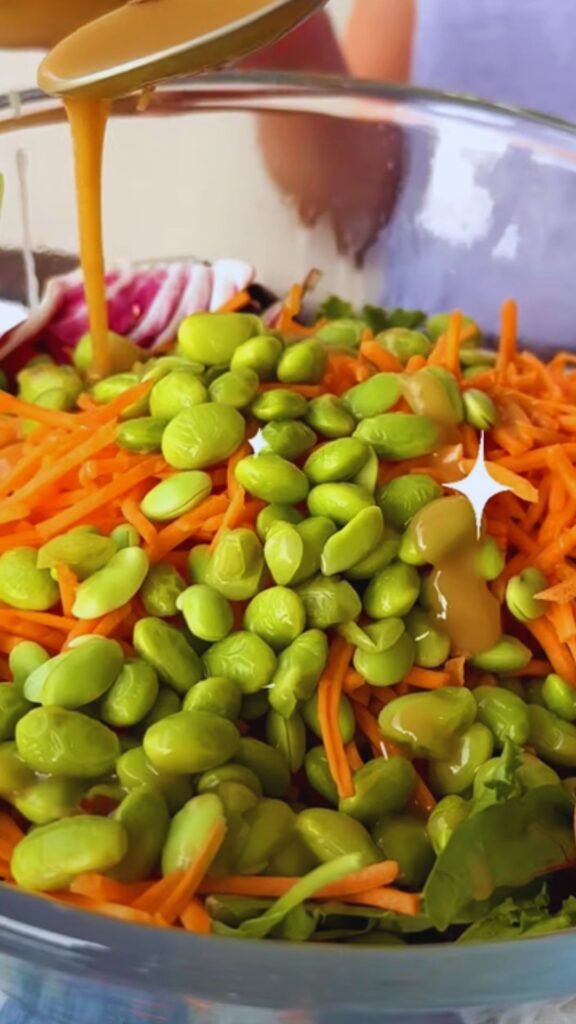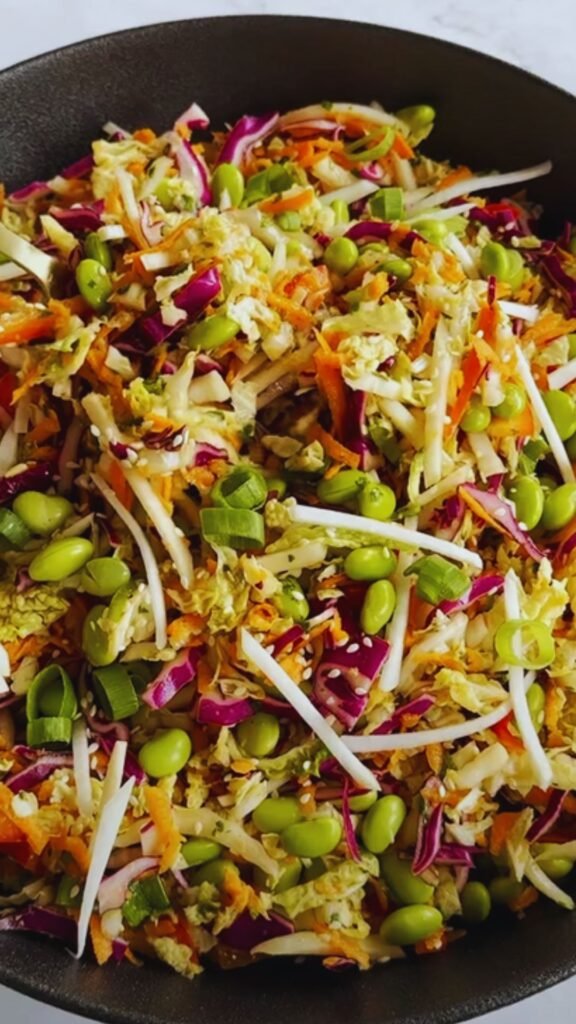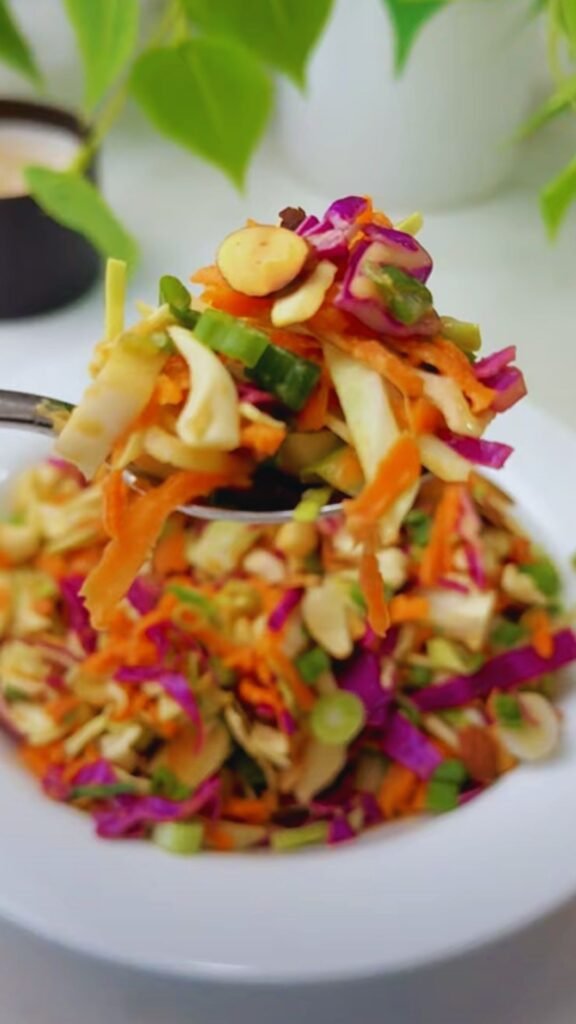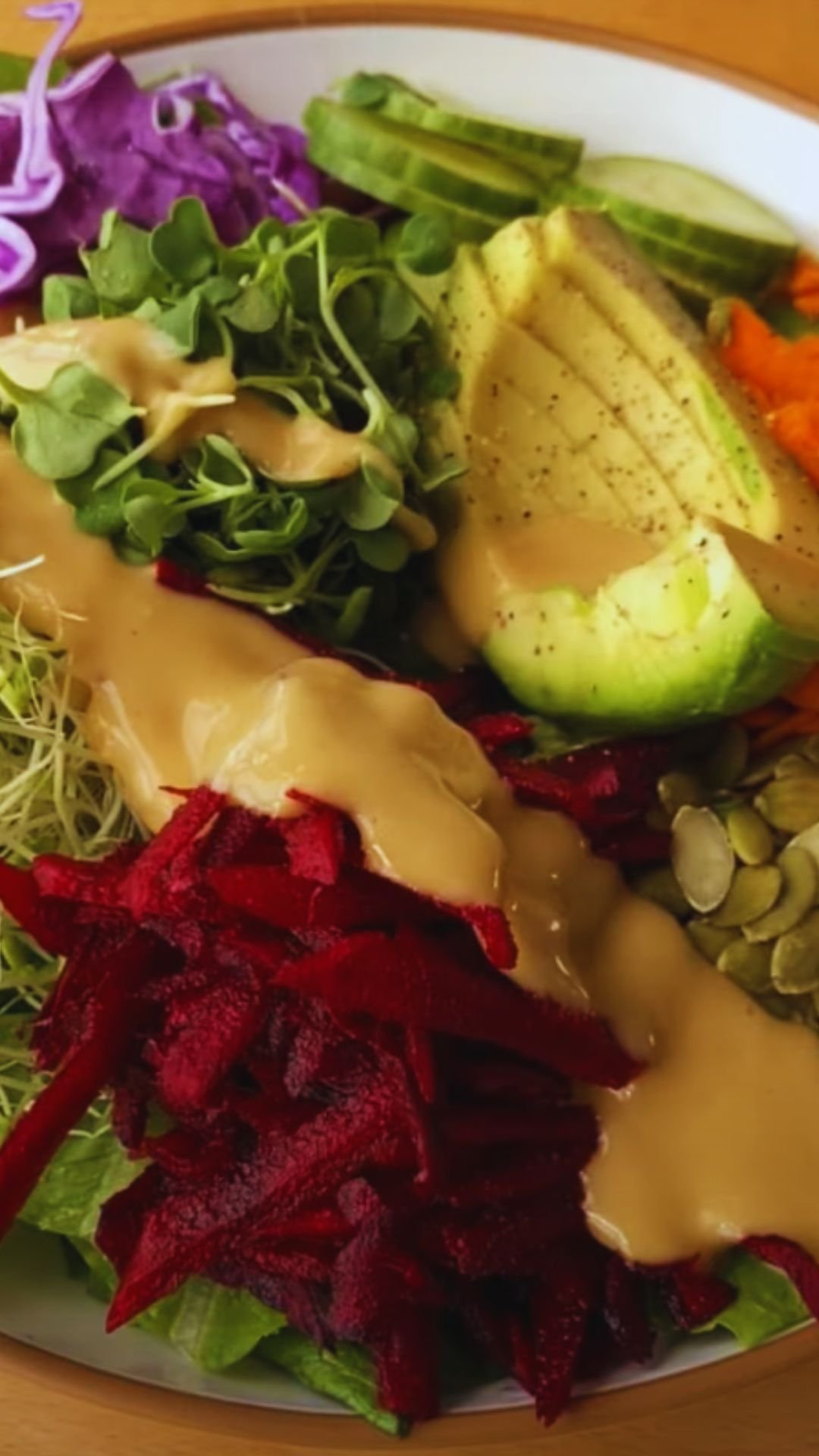There’s something incredibly satisfying about the crisp, refreshing crunch of a well-made slaw. Over the years, I’ve experimented with countless variations, but my Asian-inspired slaw with sesame ginger dressing has become a staple in my kitchen. This vibrant, colorful dish brings together the perfect balance of textures and flavors – crunchy vegetables, nutty sesame, zingy ginger, and a hint of sweetness that will make your taste buds dance.
Unlike traditional mayo-heavy coleslaws, this lighter version features a punchy vinaigrette that perfectly complements the fresh vegetables without weighing them down. Whether you’re looking for a side dish that steals the show, a light lunch option, or a topping for your favorite protein, this Asian slaw delivers every time.
The best part? It’s incredibly versatile. You can adapt it based on seasonal produce or what you have on hand, and it stays crunchy for days – making it perfect for meal prep or gatherings where you need to prepare food ahead of time.
What Makes This Asian Slaw Special
What sets this slaw apart isn’t just its vibrant colors or the irresistible crunch. It’s the harmonious balance of flavors in the dressing – toasted sesame oil adds depth, fresh ginger brings warmth and zing, while rice vinegar provides the perfect tangy note that ties everything together.
I’ve refined this recipe over countless dinner parties and family gatherings, tweaking the proportions until I found the perfect balance. The result is a slaw that’s refreshing enough to cut through rich barbecued meats yet satisfying enough to stand alone as a light meal when topped with protein.
Ingredients You’ll Need
For the Slaw Base:
- 4 cups shredded green cabbage (about half a medium head)
- 2 cups shredded red cabbage (about quarter of a medium head)
- 2 large carrots, julienned or grated
- 1 red bell pepper, thinly sliced
- 1 yellow bell pepper, thinly sliced
- 3 green onions, thinly sliced on the diagonal
- 1 cup snow peas, strings removed and thinly sliced
- ½ cup cilantro leaves, roughly chopped
- ¼ cup fresh mint leaves, thinly sliced (optional)
- ¼ cup sliced almonds, toasted
- 2 tablespoons sesame seeds, toasted (white, black, or a mix)
For the Sesame Ginger Dressing:
- ¼ cup rice vinegar
- 3 tablespoons low-sodium soy sauce or tamari
- 2 tablespoons honey or maple syrup
- 1 tablespoon freshly grated ginger
- 2 cloves garlic, minced
- 3 tablespoons toasted sesame oil
- 2 tablespoons neutral oil (like grapeseed or canola)
- 1 teaspoon Dijon mustard
- ¼ teaspoon red pepper flakes (adjust to taste)
Equipment Needed
- Sharp chef’s knife
- Cutting board
- Large mixing bowl
- Small bowl for dressing
- Whisk
- Measuring cups and spoons
- Vegetable peeler or julienne peeler (optional, for carrots)
- Airtight container for storage

Step-by-Step Instructions
Preparing the Vegetables
- Prepare the cabbage: Remove the outer leaves from both cabbages. Cut each cabbage in half through the core, then remove the core by cutting a triangle shape at the base. Place the flat side down on your cutting board and slice into thin shreds, about ⅛-inch thick. Transfer to a large mixing bowl.
- Prepare the carrots: Peel the carrots and either julienne them using a knife or vegetable julienne peeler, or grate them using the large holes of a box grater. Add to the bowl with the cabbage.
- Slice the bell peppers: Remove the seeds and membranes from the bell peppers, then slice into thin strips about 2 inches long. Add to the bowl.
- Prepare the snow peas: Remove the tough string that runs along the edge of each snow pea by pinching one end and pulling it down the length of the pod. Stack several snow peas at a time and slice diagonally into thin pieces. Add to the bowl.
- Slice the green onions: Trim the root ends and any wilted parts from the green onions, then slice thinly on the diagonal. Add to the bowl.
- Chop the herbs: Roughly chop the cilantro leaves and thinly slice the mint if using. Set aside to add just before serving.
Making the Dressing
- In a small bowl, whisk together the rice vinegar, soy sauce, honey, grated ginger, and minced garlic until well combined.
- Slowly whisk in the sesame oil and neutral oil until emulsified.
- Add the Dijon mustard and red pepper flakes, then whisk again until smooth.
- Taste and adjust seasonings as needed – add more honey for sweetness, more vinegar for tang, or more red pepper flakes for heat.
Assembling the Slaw
- Toast the sesame seeds and sliced almonds in a dry skillet over medium heat, stirring frequently, until golden and fragrant, about 3-4 minutes. Remove from heat immediately to prevent burning.
- Add the chopped herbs to the bowl with the vegetables.
- Pour about two-thirds of the dressing over the vegetables and herbs. Toss thoroughly to combine.
- Taste and add more dressing as needed until the slaw reaches your desired level of flavor.
- Sprinkle the toasted sesame seeds and almonds over the top, reserving some for garnish if desired.
- For best flavor, allow the slaw to rest in the refrigerator for at least 30 minutes before serving, though it can be enjoyed immediately.
Nutritional Profile
This Asian slaw is not just delicious – it’s packed with nutrients that make it a healthy addition to any meal. Here’s a breakdown of what you’re getting in each serving:
| Nutrient | Amount per Serving | % Daily Value | Benefits |
|---|---|---|---|
| Calories | 175 | – | Moderate calorie content makes it a filling yet light option |
| Carbohydrates | 15g | 5% | Primarily from vegetables and small amount of honey |
| Fiber | 4g | 16% | Promotes digestive health and provides satiety |
| Protein | 3g | 6% | Contributes to muscle maintenance |
| Fat | 12g | 18% | Mostly healthy unsaturated fats from sesame oil and nuts |
| Vitamin A | 5421 IU | 108% | Supports eye health and immune function |
| Vitamin C | 95mg | 158% | Boosts immune system and collagen production |
| Calcium | 70mg | 7% | Contributes to bone health |
| Iron | 1.8mg | 10% | Helps transport oxygen throughout the body |
| Potassium | 345mg | 10% | Supports heart and muscle function |
*Values are based on a 2,000 calorie diet. Your daily values may be higher or lower depending on your calorie needs.
Variations to Try
One of the reasons I love this recipe is its flexibility. Here are some of my favorite variations:
Protein Additions
- Add 2 cups of shredded rotisserie chicken for a complete meal
- Top with grilled shrimp or thinly sliced steak
- Mix in 1 cup of edamame beans for a vegetarian protein boost
- Add cubed firm tofu that’s been marinated in soy sauce and lightly pan-fried
Vegetable Variations
- Substitute thinly sliced bok choy for some of the cabbage
- Add thinly sliced Brussels sprouts for extra crunch and nutrition
- Include julienned jicama for a refreshing, crisp element
- Mix in spiralized zucchini or cucumber for a lighter version
Texture Enhancements
- Add crispy wonton strips or chow mein noodles just before serving
- Include chopped peanuts instead of almonds for a different crunch
- Mix in crispy fried shallots for an umami boost
- Top with furikake (Japanese seasoning blend) for extra flavor

Make-Ahead and Storage Tips
This slaw actually improves with a little time, as the flavors meld together. Here’s how to make it ahead and store it properly:
Making Ahead
- Prepare all vegetables up to 2 days in advance and store them separately in airtight containers lined with paper towels to absorb excess moisture.
- Mix the dressing up to 5 days in advance and store in a jar in the refrigerator. Bring to room temperature and shake well before using.
- Toast nuts and seeds up to 1 week ahead and store in an airtight container at room temperature.
Storage Guidelines
- Dressed slaw will keep in the refrigerator for 3-4 days, though the vegetables will soften slightly each day.
- For maximum crispness, store the dressing separately and combine with the vegetables just before serving.
- If storing dressed slaw, keep in an airtight container with a paper towel on top to absorb excess moisture.
Reviving Leftover Slaw
- If your leftovers have become slightly soggy, add fresh crunchy elements like sliced radishes or julienned apple.
- A squeeze of fresh lime juice can brighten up day-old slaw.
- Drain any excess liquid that may have accumulated at the bottom of the container before serving leftovers.
Serving Suggestions
This versatile slaw works beautifully in many contexts. Here are my favorite ways to serve it:
As a Side Dish
- Alongside grilled teriyaki chicken or salmon
- With Korean barbecue beef or pork
- Next to crispy tofu with peanut sauce
- With Vietnamese-style grilled shrimp
As a Main Dish
- Topped with sliced grilled chicken or steak
- Served over brown rice or quinoa with avocado
- Wrapped in rice paper with shrimp for fresh spring rolls
- Stuffed into lettuce cups with ground turkey or tofu
In Sandwiches and Wraps
- Added to banh mi sandwiches for extra crunch
- Stuffed into wraps with hummus and falafel
- Piled onto fish tacos
- Mixed with tuna salad in a whole grain wrap

The Science of Crunch: Why This Slaw Stays Crisp
I’ve always been fascinated by food science, and there’s actually some interesting science behind why this slaw maintains its satisfying crunch longer than many other salads:
Cell Structure
Cabbage and other cruciferous vegetables have rigid cell walls that break down more slowly than delicate greens like lettuce. This structural integrity is what gives slaw its characteristic crunch.
Salt and Acid Effects
The salt in the soy sauce and the acid in the rice vinegar actually help maintain crispness by drawing out some moisture initially, which causes the vegetables to become slightly more firm through osmotic pressure.
Low Water Content
Unlike mayonnaise-based slaws, this vinaigrette-style dressing doesn’t introduce excessive moisture that can make vegetables soggy. The oils in the dressing actually create a slight barrier that helps preserve the vegetables’ natural crunch.
Preparation Technique
Cutting the vegetables into thin, consistent pieces creates more surface area for the dressing while maintaining structural integrity – the perfect balance for texture and flavor absorption.
Health Benefits of Asian Slaw Ingredients
Beyond its delicious taste, this slaw is packed with nutrient-dense ingredients that offer numerous health benefits:
Cabbage
Red and green cabbage are low in calories but high in vitamins C and K, and contain compounds called glucosinolates that have been studied for their potential cancer-fighting properties.
Bell Peppers
These colorful vegetables are among the richest sources of vitamin C available – a single red bell pepper contains more vitamin C than an orange! They’re also rich in vitamin A and antioxidants.
Ginger
Fresh ginger contains gingerol, a bioactive compound with powerful anti-inflammatory and antioxidant properties. It’s been used for centuries to aid digestion and reduce nausea.
Sesame Seeds
These tiny seeds pack a nutritional punch, offering protein, fiber, healthy fats, calcium, and zinc. The sesame oil in the dressing contains sesamol and sesaminol, compounds with antioxidant effects.
Carrots
Rich in beta-carotene, which the body converts to vitamin A, carrots support eye health and immune function. They also provide fiber and various beneficial plant compounds.
Troubleshooting Tips
Even experienced cooks encounter challenges. Here are solutions to common slaw-making problems:
Problem: Bitter Cabbage
Solution: If your cabbage has a bitter taste, try soaking the shredded cabbage in cold water with a tablespoon of salt for 15 minutes, then drain and pat dry before proceeding with the recipe.
Problem: Too Much Dressing
Solution: Add more vegetables or a handful of pre-washed salad greens to absorb the excess. If making ahead, reserve some of the dressing and add only as needed.
Problem: Too Tart
Solution: Balance excessive acidity with a bit more honey or a pinch of sugar. A drizzle of neutral oil can also help mellow tartness.
Problem: Bland Flavor
Solution: Try adding a splash of fish sauce or a squeeze of lime juice to enhance umami flavors. Make sure your sesame oil is fresh, as it loses potency over time.
Problem: Watery Slaw
Solution: Drain excess liquid before serving, or add a tablespoon of chia seeds to absorb moisture while adding nutrition.
Seasonal Adaptations
I love adapting this slaw throughout the year to incorporate seasonal produce:
Spring Version
- Add thinly sliced sugar snap peas
- Include shaved asparagus
- Mix in radishes and their greens
- Top with microgreens or pea shoots
Summer Version
- Add fresh corn kernels
- Mix in diced mango or peach
- Include thinly sliced cucumber
- Top with fresh basil instead of mint
Fall Version
- Add thinly sliced apples or pears
- Include roasted butternut squash cubes
- Mix in thinly sliced Brussels sprouts
- Top with pomegranate seeds
Winter Version
- Add citrus segments like mandarin or grapefruit
- Include roasted sweet potato cubes
- Mix in finely shredded kale
- Top with dried cranberries
Frequently Asked Questions
Q: Can I make this slaw ahead of time for a party?
A: Absolutely! This slaw actually improves after sitting for a few hours as the flavors meld. For maximum crunch, you can prepare all the vegetables and the dressing up to 24 hours ahead, store them separately in the refrigerator, and combine about 30 minutes before serving.
Q: Is this recipe gluten-free?
A: It can be! Just make sure to use tamari instead of regular soy sauce, and check that your rice vinegar doesn’t contain added ingredients with gluten. All other ingredients are naturally gluten-free.
Q: I don’t like cilantro. What can I substitute?
A: If you’re among those who find cilantro tastes soapy (it’s genetic!), you can simply omit it or substitute with flat-leaf parsley, Thai basil, or additional mint. Each will provide a different but complementary flavor profile.
Q: How can I make this recipe vegan?
A: This recipe is nearly vegan as written – just substitute the honey with maple syrup or agave nectar, and you’re all set!
Q: Can I use pre-shredded cabbage to save time?
A: Yes, pre-shredded cabbage or coleslaw mix can be a great time-saver. Just be aware that pre-shredded vegetables won’t stay fresh as long as whole vegetables that you cut yourself. I recommend adding your own julienned carrots, peppers, and herbs to the pre-shredded cabbage for the best flavor and texture.
Q: My family doesn’t like spicy food. Can I omit the red pepper flakes?
A: Absolutely. The red pepper flakes add a gentle heat that complements the ginger, but the dressing is delicious without them. You could add a dash of black pepper instead for a milder warmth.
Q: How long will leftover slaw keep in the refrigerator?
A: Dressed slaw will keep for 3-4 days in an airtight container in the refrigerator. The vegetables will soften slightly but will still be delicious. For maximum crispness, store the dressing and vegetable mixture separately and combine only what you’ll eat each time.
A Note on Knife Skills
Creating a truly excellent slaw comes down to how you cut the vegetables. Here are some tips for achieving those perfect, uniform pieces that make for the best texture:
Cabbage
For the thinnest, most delicate shreds, a sharp chef’s knife is key. After removing the core, place the flat side down and slice as thinly as possible, aiming for ⅛-inch strips. Periodically reorganize your cabbage pieces as you cut to maintain control.
Carrots
For the most professional results, julienne your carrots by hand: cut into 2-inch segments, slice thinly lengthwise, stack those slices, and cut again into matchsticks. For a quicker method, a julienne peeler creates perfect carrot strips in seconds.
Bell Peppers
For the most attractive pieces, slice off the top and bottom of the pepper, make one vertical slice, and open it flat. Remove the white membranes and seeds, then slice into thin strips of even width.
Consistent Sizing
The secret to a cohesive slaw is cutting all vegetables to similar dimensions. This ensures even distribution of the dressing and a balanced bite every time.
Final Thoughts
What I love most about this Asian slaw is its ability to transform an ordinary meal into something special. The vibrant colors, crisp textures, and bold flavors create a dish that’s both refreshing and satisfying. Whether served alongside grilled meats at a summer barbecue, packed into a lunch box, or enjoyed as a light dinner topped with protein, this slaw brings excitement to the table.
The beauty of cooking lies in making recipes your own, so I encourage you to experiment with the variations I’ve suggested or create your own based on your preferences and what’s in season. The framework of crunchy vegetables and zingy sesame ginger dressing provides endless possibilities for customization.
I hope this recipe brings as much joy to your kitchen as it has to mine. Happy cooking!


